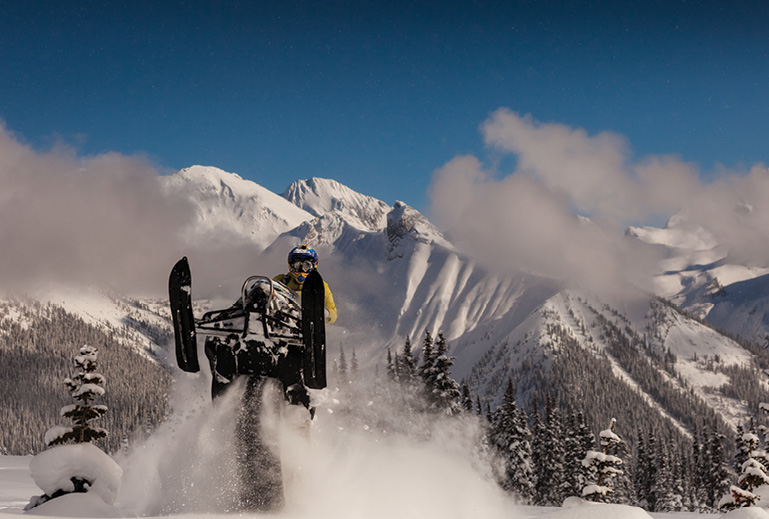In these recent years of snowless Novembers, especially on the Canadian prairies, it’s not a bad idea for an avid snowmobiler to look west to a place like Golden, B.C.
“It’s a little warmer than it’s been the last couple years to start, but that’s okay,” said Golden Snowmobile Club secretary, Aaron Bernasconi. “It’s been snowing since October, so we’e dealing with a 140-centimetre snowpack right now, which is pretty good for November. We’re on par for last year’s snowpacks.”
“We get a lot of Saskatchewan plates in town and I think that’s been pretty important to our industry,” said Magi Scallion, the club’s newly installed executive director. “It’s a long drive for them, but we’re closer than some other areas and every year we’re building our reputation as an excellent snowmobiling destination.”
Golden lies an hour inside of the B.C. border on the Trans-Canada Highway, alongside the Columbia River and is, not surprisingly, surrounded by mountains. The town itself is not a big community, with an immediate population of about 4,000, and another 4,000 in the surrounding district.
“It’s a small area, but we’re only three hours from Calgary and a lot of visitors take advantage of that,” said Scallion.
“I think we are seeing bigger numbers coming from further out east,” said Bernasconi. “But I think as the years go on, the club’s doing a pretty good job marketing towards tourism. We’ve increased every year for the last five or six years, last year being the biggest of all.”
“We try and tell it ow it is. If it’s good, we say it’s good and if it’s not good, we say where it can be good or what places you should avoid.”
Aaron Bernasconi, Secretary, Golden Snowmobile Club
For snowmobilers, the area’s main sledding organization is run under “Sled Golden,” an amalgamation of two organizations, both of which have the same board members: the membership-based Golden Snowmobile Club (320 members) and the Golden Snowmobile Trail Society.
“It started out as just a club,” said Bernasconi, who has been with the organization for about a decade, he estimates. “There were a few local business owners who were quite heavily involved – Randy and Dawn Baun, they used to own a dealership here in town and they were heavily involved in the whole development and progression through the years. They were big advocates of getting the whole grooming program started.
“Members back then were mostly volunteers and it was like a recreational group who did club rides together and treated it more as what most people would consider a club of days gone by; they’d throw out a message that they were riding on [a particular] day and then all the members would show up and ride together. As the years went on, it sort of changed into the introduction of grooming the trails. And once it went from a club-type vibe to a more commercial-type vibe, they developed a new identity called the Golden Snowmobile Trails Society, and that group was in charge of income and expenditures, versus the club, which is more focused on volunteering.”
The group also manages an impressively long list of sponsors.
“Tourism Golden produces maps, and they were producing the snowmobile trail maps, which is great,” said Scallion. “And the club negotiated with them two years ago because they would sell advertising on the map to their members. We negotiated so that we could sell that advertising as sponsorship and I think that’s where the sponsorship program really took a big turn because we could sell all those spots on the map; 5,000 copies of the map are distributed, we take them to trade shows. We have them at all of our trailheads. So that’s a big value to our sponsors and it’s really made a change.”
Today, it’s quite a vast area that Sled Golden oversees.
“We have tenure on the four primary areas: Quartz Creek, Gorman Lake, Silent Pass and Westbench Trail,” said Scallion. “Those four areas, we hold a Section 57 tenure agreement on. And as for the other eight areas, as shown on our website, we do not hold tenure on them so we cannot do maintenance on those, but they are commonly used areas and are great riding, too! Altogether, we groom 165 kilometres of trail.”
Scallion estimates that the organization has less than a half dozen employees (most of them are for collecting day fees) and about 20 volunteers. They contract out the trail grooming, as well.
“We hire a contracting company to do it,” she said. “So, unlike a whole lot of other clubs, we don’t own the groomer machines and we don’t pay for the maintenance on them; we just subcontract that out to Kelly [Bushman].”
But the high-demand area combined with the amazing landscape and small local population provides some logistical challenges for the club, says Scallion.
“We have quite a high percentage of members from out of town, which also leads us to a lack of club events. Because we don’t have a lot of locals, it’s not as easy to get them involved.”
The beautiful location also has pros and cons of its own.
“I think [the landscape] is to our benefit and also to our detriment a little bit,” said Scallion, regarding the local terrain. “Speaking to our board members, I think our weakness is that we don’t have a ton of beginner riding areas. And places like Gorman Lake, it’s spectacularly beautiful. It’s a hiking area in the summer and it’s just gorgeous. But it’s also big mountains and avalanche paths and all the rest. It’s a beautiful place to go but it’s also quite intimidating. Revelstoke is just down the road from us, and they have a lot of riding areas that have both beginner opportunities and also more advanced stuff. And so that’s something we’re looking to improve.”
Another challenge the terrain presents has received a lot more attention in recent years.
“Obviously, we’re a mountain-based community and we take the whole avalanche program very seriously,” said Bernasconi. “We’re in the process of completing what’s called an avalanche safety plan. That’s something that’s been a big part of the last couple years, the progression and development of it. That’s going to affect when and where we can groom and how high, elevation-wise. It’s changing the way we groom trails; we’re trying to make sure our groomers are staying safe.”
Developing the avalanche safety plan has involved ongoing research during the past several winter seasons.
“A lot of it, the last couple years, has been information gathering, starting to track the number of snowfalls and the frequency of the avalanche paths,” he said. “I think we have a pretty solid plan and it’s going to be one of those things we utilize on a daily basis.”
One of the club’s particular strengths is their approach to communications; Sled Golden has active social media accounts and is quick to upload new information.
“It’s something that we’ve emphasized right from the beginning; we’re definitely focused on marketing but we also don’t try to pull the wool over anybody’s eyes,” said Bernasconi, on reporting about conditions. “We try and tell it how it is. If it’s good, we say it’s good and if it’s not good, we say where it can be good or what places you should avoid.”
Bernasconi is one of the crewmembers who monitors the snowpack and if there is a weekend trip planned, there will be evidence of it online later that day.
“It looks like we’re supposed to get another 30 centimetres [of snow] this afternoon, tonight and tomorrow morning – it looks like it’s going to be a good snowmobile day.”



![[image placeholder]](https://www.snowopsmag.com/wp-content/uploads/2023/09/placeholder@2x-890x664.png)